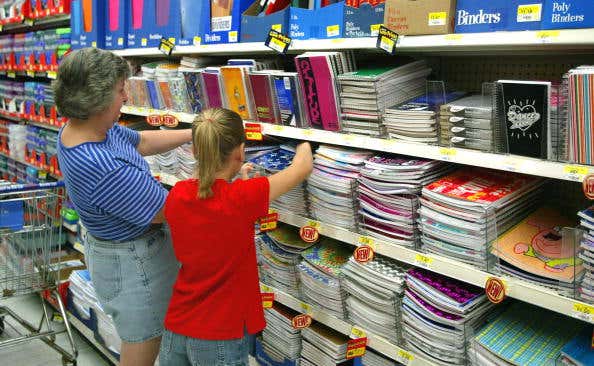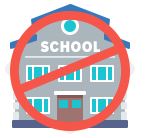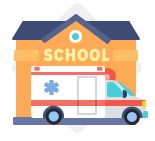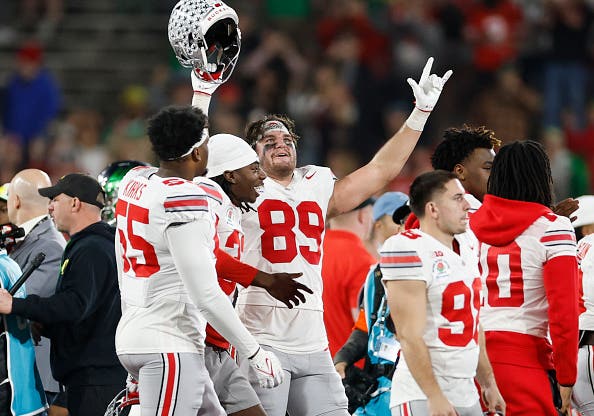
(Photo by Tim Boyle/Getty Images)
We know the price of everything has gone up and the cost of back to school shopping has reached an all-time high.
Ah, the sweet smell of freshly sharpened pencils and the sight of brand new backpacks lining the shelves. I used to love back to school shopping. Now, of course, I was a kid so it didn't come out of my pocket. But going up and down the aisles picking the perfect folders and pencils was so much fun. It's hard to believe kids here in Southwest Florida will be bidding farewell to summer fun in Fort Myers, Cape Coral and Naples and heading back to school on Thursday already.
I'm sure most parents are scrambling this week to finish checking off those school supply lists. And with that, I have no doubt they're taking notice of the cost of these items. If you feel like you're paying more this year than in prior years, you're right. A new study by the National Retail Federation shows that back to school spending is expected to reach $41.5 billion, up from $36.9 billion last year. The higher prices are having families spending more than ever, as well as the higher demand for electronics like laptops and tablets.
Here are some tips to help save money on back to school shopping:
It's always good to save money where you can. First, before you hit the stores, raid your home and last year's backpack for any school supplies that are still in good condition and can be reused. You may be surprised by how many items you already have. Second, create a budget and stick to it. To follow it, you may compare prices from store to store or use coupons where you can to get more bang for your buck. Third, weekdays and early mornings tend to be less crowded, allowing you to browse without the chaos and distractions. And finally, stick to the essentials. There's lots of wants, but stick to the needs.
New Report Shows Florida Has the 9th Best School System in America
The Florida school system have been in the news a lot lately. Even though much that is said is negative, it turns out, our schools actually grade fairly well. When you look past the headlines and dig into the data, it seems things aren't bad at all. In fact, this new report from Wallethub shows that Florida has the 9th best school system in America.
In order to determine the best school systems in America, WalletHub compared the 50 states and the District of Columbia across 32 key measures of quality and safety. The data set ranges from pupil-teacher ratio and dropout rate to median standardized-test scores. We'll break down fully where the numbers come from in a bit, but here's the snapshot.
Quality & Safety of Schools in Florida (1=Best; 25=Avg.):
All very respectable numbers. Also, as you plan for Back To School, keep in mind that this is the Tax Free Week for school supplies in Florida. Prices have gone up on everything, so save where you can.
Now, unlike other research that focuses primarily on academic outcomes or school finance, WalletHub’s analysis takes a more comprehensive approach. It accounts for performance, funding, safety, class size and instructor credentials. To determine the top-performing school systems in America, WalletHub compared the 50 states and the District of Columbia across 32 key metrics.
Main Findings
Public School Ranking by State
Note: With the exception of “Total Score,” all of the columns in the table above depict the relative rank of that state, where a rank of 1 represents the best conditions for that metric category. To see all 51, see the full report here.
Dropout Rate
- 1. West Virginia
- 2. Iowa
- 3. Kentucky
- 4. New Jersey
- 5. Indiana

- 47. Oklahoma
- T-48. Alaska
- T-48. Arizona
- T-48. New Mexico
- T-48. District of Columbia
Math Test Scores
- 1. Massachusetts
- 2. Wyoming
- 3. Utah
- 4. Nebraska
- 5. Wisconsin
- 47. Oklahoma
- 48. Delaware
- 49. West Virginia
- 50. District of Columbia
- 51. New Mexico
Reading Test Scores
- 1. Massachusetts
- 2. New Jersey
- 3. Utah
- T-4. Colorado
- T-4. New Hampshire
- 47. Oklahoma
- 48. Alaska
- 49. District of Columbia
- 50. West Virginia
- 51. New Mexico
Median SAT Score
- 1. Wisconsin
- T-2. Kansas
- T-2. Utah
- T-2. Wyoming
- T-5. Minnesota
- T-5. Nebraska
- T-46. Delaware
- T-46. New Mexico
- T-46. Rhode Island
- 49. Oklahoma
- T-50. District of Columbia
- T-50. West Virginia
Median ACT Score
- 1. District of Columbia
- T-2. California
- T-2. Connecticut
- T-2. Massachusetts
- 5. New Hampshire

- T-44. Alabama
- T-44. Arizona
- T-44. Louisiana
- T-44. Mississippi
- T-44. North Carolina
- T-44. Oklahoma
- T-44. Tennessee
- 51. Nevada
Pupil-Teacher Ratio
- 1. Vermont
- 2. Maine
- 3. District of Columbia
- 4. New Hampshire
- 5. New Jersey

- 47. Alabama
- 48. Nevada
- 49. California
- 50. Arizona
- 51. Utah
% of Threatened/Injured High School Students
- 1. Delaware
- 2. California
- 3. North Carolina
- 4. Maine
- 5. Massachusetts

- T-40. Idaho
- T-40. Texas
- 42. Kansas
- 43. Alabama
- 44. Mississippi
- 45. Louisiana
Bullying Incidence Rate
- 1. District of Columbia
- 2. Delaware
- 3. Hawaii
- 4. Rhode Island
- 5. Virginia
- 44. Iowa
- 45. Wyoming
- 46. New Hampshire
- 47. West Virginia
- 48. Alaska
Methodology
In order to determine the best and worst states for public-school education, WalletHub compared the 50 states and the District of Columbia across two key dimensions, “Quality” and “Safety.”
We evaluated those dimensions using 32 relevant metrics, which are listed below with their corresponding weights. Each metric was graded on a 100-point scale, with a score of 100 representing the highest quality of public K–12 education.
Finally, we determined each state and the District’s weighted average across all metrics to calculate its overall score and used the resulting scores to rank-order our sample.
Quality – Total Points: 80
Safety – Total Points: 20
Sources: Data used to create this ranking were collected from the U.S. Census Bureau, U.S. Department of Education, National Conference of State Legislatures, National Center for Education Statistics, Centers for Disease Control and Prevention, Western Interstate Commission for Higher Education, Office of Juvenile Justice and Delinquency Prevention, Child and Adolescent Health Measurement Initiative, Education Commission of the States, U.S. News & World Report, College Board, Ballotpedia, ACT, State Educational Technology Directors Association, Civil Rights Data Collection and Zendrive.





